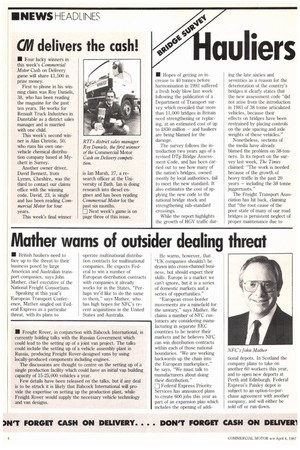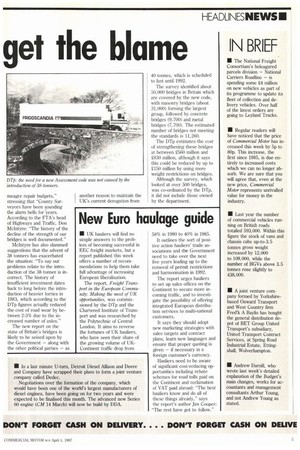auliers get the blame
Page 6

Page 7

If you've noticed an error in this article please click here to report it so we can fix it.
• Hopes of getting an increase to 40 tonnes before harmonisation in 1992 suffered a fresh body blow last week following the publication of a Department of Transport survey which revealed that more than 11,000 bridges in Britain need strengthening or replacing, at an estimated cost of up to £830 million — and hauliers are being blamed for the damage.
The survey follows the introduction two years ago of a revised DTp Bridge Assessment Code, and has been carried out to see how many of the nation's bridges, owned mostly by local authorities, fail to meet the new standard. ft also estimates the cost of applying the new code to the national bridge stock and strengthening sub-standard crossings.
While the report highlights the growth of HG‘,' traffic dur
ing the late sixties and seventies as a reason for the deterioration of the country's bridges it clearly states that the new assessment code "did not arise from the introduction in 1983 of 38 tonne articulated vehicles, because their effects on bridges have been restrained by placing controls on the axle spacing and axle weights of these vehicles."
Nonetheless, sections of the media have already blamed the problem on 38-tonners. In its report on the survey last week, The Times claimed: "The work is needed because of the growth of heavy traffic in the past 20 years — including the 38 tonne juggernauts."
The Freight Transport Association has hit back, claiming that the root cause of the poor state of many of our road bridges is persistent neglect of proper maintenance due to meagre repair budgets," stressing that "County Surveyors have been s.ounding the alarm bells for years. According to the FTA's head of Highways and Traffic, Don McIntyre: "The history of the decline of the strength of our bridges is well documented."
McIntyre has also slammed suggestions that the advent of 38 tonners has exacerbated the situation: "To say our problems relate to the introduction of the 38 tonner is incorrect. The history of insufficient investment dates back to long before the introduction of heavier lorries in 1983, which according to the DTp figures actually reduced the cost of road wear by between 2-3% due to the increased number of axles."
The new report on the state of Britain's bridges is likely to be seized upon by the Government — along with the other political parties — as another reason to maintain the UK's current derogation from 40 tonnes, which is scheduled to last until 1991
The survey identified about 50,000 bridges in Britain which are covered by the new code, with masonry bridges (about 31,000) forming the largest group, followed by concrete bridges (9,700) and metal bridges (7,700). The estimated number of bridges not meeting the standards is 11,26a
The DTp estimates the cost of strengthening these bridges at between .£560 million and £830 million, although it says this could be reduced by up to £150 million by using more weight restrictions on bridges.
Although the survey, which looked at over 500 bridges, was co-ordinated by the DTp, it did not include those owned by the department.




















































































